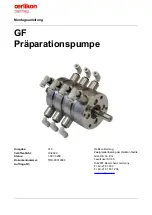
20
FLOW CENTER INSTALLATION AND LOOP FLUSHING MANUAL
“P” Series/ “E” Series equipment includes freeze protection thermistors to protect the water-to-refrigerant heat exchang-
er (coax) from damage caused by freezing liquid. Be sure the “Loop/Well” DIP switch is in the “Loop” position if antifreeze is
used and in the “Well” position if plain water is used in the loop.
Selection of the antifreeze solution for closed loop earth coupled systems requires the consideration of many important
factors which have long-term implications on the performance and life of the equipment. Each area of concern leads to a
different “best choice” of antifreeze. The fact is that there is no “ideal” antifreeze and any choice will require compromises in
one area or another. Some of the factors to consider are:
Safety—
The toxicity and fl ammability of the brine (antifreeze
solution of any type).
Thermal performance—
The heat transfer and viscosity effects
of the brine.
Cost—
The prices vary widely.
Corrosiveness—
System materials must be compatible with the brine.
Stability—
Will the brine require periodic change out or maintenance?
Convenience—
Is the brine available and easy to transport and install?
Codes—
Will the brine meet local and national regulatory standards?
The following are some general observations about the types of brine presently being used:
Methanol—
Considered toxic in pure form, good heat transfer, low to mid price, fl ammable in concentrations greater than
25%, non-corrosive, low viscosity.
Ethanol (Environol 1000 and 2000)—
Good heat transfer (slightly less than methanol), high price, fl ammable in concentra-
tions greater than 25%, non-corrosive and low viscosity.
Propylene glycol—
Nontoxic-noncorrosive, expensive, hard to handle when cold, poorest heat transfer, has formed “slime-
type” coatings inside pipe. Poor heat transfer has required its removal in some systems.
GS4 (Potassium acetate)
—
Due to its low surface tension, GS4 is known to leak through mechanical fi ttings and most
thread sealants. It is corrosive when exposed to air. The manufacturer does not recommend use of GS4 with its products.
Note:
Consult with your representative or distributor if you have any questions regarding antifreeze selection, or any com-
ments to report about problems or success with any particular methods.
Antifreeze Selection And Use
Type
Size
Volume
(U.S. Gal/100’ Pipe)
Volume
(Liters/10 Meters)
Copper
1" CTS
4.1
15.5
Copper
1.25" CTS
6.4
24.2
Copper
1.5" CTS
9.2
34.8
Polyethylene
.75" - IPS SDR 11
3.0
11.4
Polyethylene
1" - IPS SDR 11
4.7
17.8
Polyethylene
1.25" - IPS SDR 11
7.5
28.4
Polyethylene
1.50" - IPS SDR 11
9.8
37.1
Polyethylene
2" - IPS SDR 11
15.4
58.3
Approximate Fluid Volume per 100’ of Pipe
Type
Minimum Temperature for Freeze Protection
10
°
F (-12.2
°
C)
15
°
F (-9.4
°
C)
20
°
F (-6.7
°
C)
25
°
F (-3.9
°
C)
Methanol*
25%
21%
16%
10%
Environol™ 1000* (premix)
100%
87%
72%
48%
Environol™ 2000* (pure)
27%
24%
20%
13%
Antifreeze Requirements
Notes:
Not all currently available in all areas. All % are by volume.
Caution: Use extreme care when open-
ing, pouring and mixing fl ammable
antifreeze solutions. Remote fl ames or
electrical sparks can ingnite undiluted
antifreezes and vapors. Use only in
a well-ventilated area. Do not smoke
when handling fl ammable antifreezes.
Failure to observe safety precautions
may result in fi re, injury or death.





































